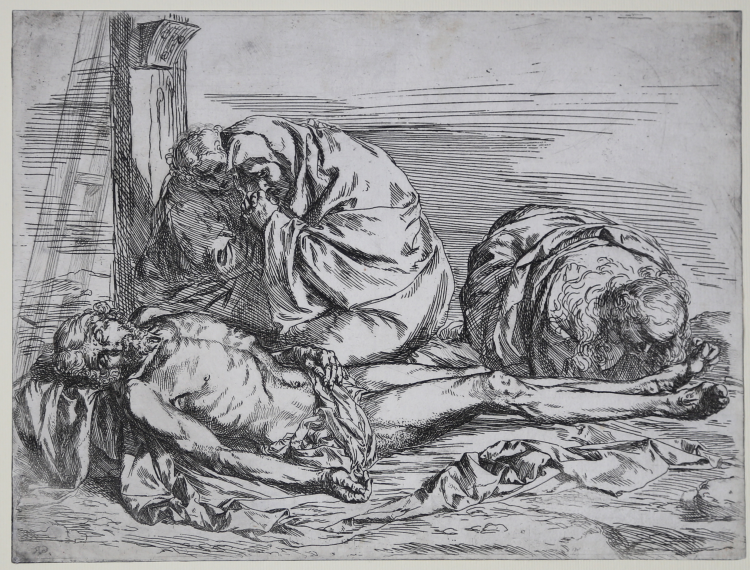




| Reference: | S39272 |
| Author | Jusepe di RIBERA detto "lo Spagnoletto" |
| Year: | 1621 ca. |
| Measures: | 245 x 337 mm |



| Reference: | S39272 |
| Author | Jusepe di RIBERA detto "lo Spagnoletto" |
| Year: | 1621 ca. |
| Measures: | 245 x 337 mm |
Etching and drypoint, 1621 circa, with a false monogram GR in reverse added in the left lower corner. Example in the third final state, with numerous hatchings along the staircase and on the cross.
Magnificent example, with plate tones, printed on contemporary laid paper, trimmed to the marginal line, in excellent condition.
This etching is sometimes excluded from Ribera’s ouvre. Its relative coarseness suggested to August Mayer that it was reworked by a student, and it was later rejected by several sholars including, initially, Jonathan Brown. However, there is evidence in favor of its autograph status. The monogram in the lower left corner is false, but the existence of an impression in Rome (Gabinetto Nazionale), printed before it was added, suggests that its insertion was intended to identify the author of the work. Finally, an impression of “Saint Jerome Reading in Boston has a faint printing or maculatature of “The Lamentation” on the verso, which supports the attribution to Ribera.
Giulio Mancini, in his treatise “Considerazioni sulla pittura” of 1620, mentions a “Christo Deposto” as a painting done by Ribera in Rome. Given the presumed early date of the etching, it may very well reflect this important lost painting (both The Lamentation now in Louvre and that in the National Gallery London, have been put forward as possibly the painting mentioned by Mancini). The composition of the print is closest to the painting now in London, which may be an early work but which shares characteristics with other works by Ribera of the same subject.
|
TIB, 44.269.1; Brown 17, III/III; Bayer, 384.3.17; Pérez Sánchez – Spinosa (1992), n. 87.
|
Jusepe di RIBERA detto "lo Spagnoletto" (Jatiba circa 1590 - Napoli 1652)
|
Spanish painter and printmaker, active in Italy. He was one of the most important figures in European painting in the 17th century and one of the major artists of the Counter-Reformation. Though Spanish, he spent his entire career in Italy, and his evolution reflected developments in Italian art at that time. His first works show the influence of northern followers of Caravaggio active in Rome. He subsequently incorporated elements of Venetian art and, in his last works, combined all the sensual and colourist opulence of both Venice and Flanders, creating new and highly personal compositions.
|
|
TIB, 44.269.1; Brown 17, III/III; Bayer, 384.3.17; Pérez Sánchez – Spinosa (1992), n. 87.
|
Jusepe di RIBERA detto "lo Spagnoletto" (Jatiba circa 1590 - Napoli 1652)
|
Spanish painter and printmaker, active in Italy. He was one of the most important figures in European painting in the 17th century and one of the major artists of the Counter-Reformation. Though Spanish, he spent his entire career in Italy, and his evolution reflected developments in Italian art at that time. His first works show the influence of northern followers of Caravaggio active in Rome. He subsequently incorporated elements of Venetian art and, in his last works, combined all the sensual and colourist opulence of both Venice and Flanders, creating new and highly personal compositions.
|